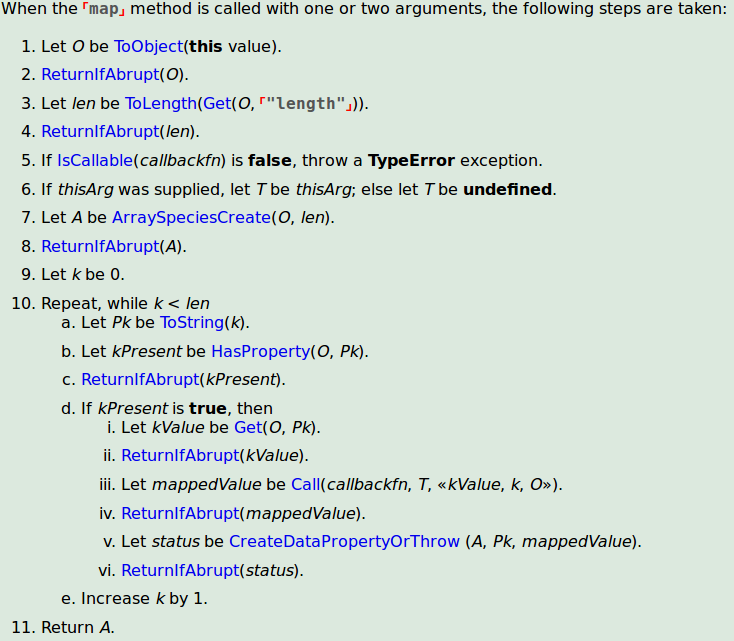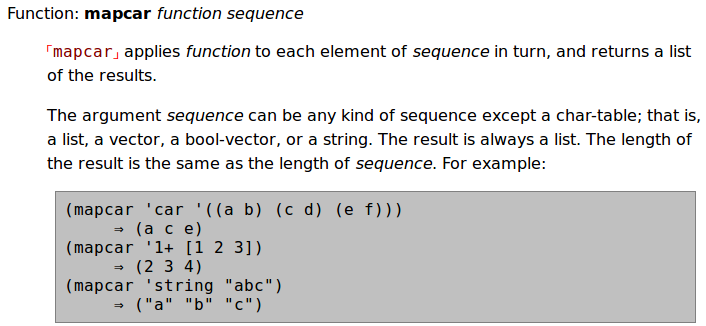Comp Lang: is the Map Function Functional Programing in Syntax or Semantics
In most language today, there's a “map” function, and encouraged by programers as good style. Map is typically used like this: map(function, list).
There's a critical point in the language spec on the behavior of “map”. Namely, whether the language specifies that the function passed to map must not have side-effects.
JavaScript Example
in JavaScript, its map is Array.prototype.map(f). However, the spec says it must be computed as a loop, that is, apply the function to elements in order.

〔see JS: Array.prototype.map〕
This means, JavaScript compiler cannot compile it into running parallel on multiple CPUs. It must apply the function to array element one at a time, in order.
Automatic parallel computation advantage of using map is lost.
See: Guy Steele on Parallel Programing. (Get rid of lisp cons) 2011
So, when you use “map” in JavaScript, the advantage is merely syntactical.
Lisp Example
In emacs lisp, the spec says the list elements are applied “in turn”.

So, this also means, it thwarts automatic parallel computation.
Consequence of the Map Function Spec
When a language, specifies the map behavior such that:
- the function used in map must have no side-effects.
- and or, the order of the function applying to the list element, is not specified.
Then, such language's “map” function can safely do automatic parallel computation.
Without the above requirement, the “map” is simply useful as a clean syntax of iteration.
Enforce or Not, and How
If a language specifies that the function passed to map must not have side-effects, then, there is the question of whether the language enforces it. If so, how.
If the language does not enforce it, then, the result can be tricky. Because, programers may just ignore it, or due to ignorance, and use map with function that has side-effect. The result is that, sometimes it may not work, and is hard to debug. Then, it creates a shroud of confusion.
If the language does enforce it, then the question is how. It will need a way to make sure that function does not have side effects. For most languages, such as lisp, JavaScript, Java, Python, there is no mechanism in the language to do this.
Conclusion
So, the conclusion here is, that even many of today's languages have “map”, but it is merely a trivial advantage of readability or syntactic style. The real fruit, the math properties that propel automatic transparent parallel computation, isn't there.
Then, given the situation, there's the question of whether you should still use “map” (or just go with iteration.).
It is still better to use map. Because, using “map” gives a explicit indication to readers, that the function does not have side-effects, and the order of application to list doesn't matter. In practice, most use of map does follow this.
In GNU Emacs community, I believe there's implicit coding style convention that tell people to use iteration (dotimes and related) instead of “mapcar”. That's not good.
Programing Language Design
- Ontology of Programing Languages
- Comp Lang: Why I Hate Exceptions
- Comp Lang: Iterator, Enumerator, Abstraction Went Wrong (2016)
- Comp Lang: Should Array Index Start at 0 or 1?
- Why C Language Has the Main Function
- Comp Lang: is the Map Function Functional Programing in Syntax or Semantics
- Comp Lang: Should Map Function Specify Order
- Coding Style: Abuse of Logic Operators (Short-Circuit) as Control Flow (2015)
- Comp Lang: Bit Operators Idiocy
- Comp Lang: Hack of Bitmask as Boolean Parameters (2007)
- Comp Lang: Function Dependency
- The Complexity of Java Access Specifiers
- Comp Lang: C Cpp Java Coders Don't Know Scientific Programing Languages